Chris Smith and Adam Murphy head to Edinburgh Science Festival to bring you the best - and the bizarre - from the wonderful world of science. Joining them are Chris Johnson, Head of Computer Science at Glasgow University, Sophie Goggins, Curator of Biomedical Science at National Museums Scotland as well as astrophysicist Beth Biller and microbiologist Luke McNally, from the University of Edinburgh. Plus the team were also be joined by Sir Ian Wilmut, one of the brains behind the pioneering work of Dolly The Sheep.
In this episode

06:54 - Best Tech: Keeping the nation safe online
Best Tech: Keeping the nation safe online
with Chris Johnson, University of Glasgow
Chris Smith asks computer scientist Chris Johnson from Glasgow University to take us through his favourite technology...
Chris J - The National Cyber Security Center if you like is the public facing part of GC HQ that's responsible for promoting the cyber security of the country as a whole. And the more things that we rely on in our daily lives for computational infrastructure the more we're going to have to look to people like them to protect us against the growing range of threats. When I worked at NASA we did things like fault injection, so deliberately putting bugs into our own code. Then we would give it to testers, and if they came back and they'd said we found eight bugs and you'd already put in 10 - keep testing keep testing, and then one time they edited the code made the changes tried to track down bugs, and they came back and after about six months still only found nine bugs, and we're like OK we'll show you where it is. And then we couldn’t find the bug that we deliberately put in ourselves. That's a bad day. But the reason for telling that story is that the thing that I wanted to talk about was the national cybersecurity center because this is the kind of connection between the space safety stuff I did first and the cybersecurity stuff, right? The connection is this: Dykstra said testing proves the presence of bugs not the absence. Right. When you run an antiviral checker on your computer, does that mean your computer is clean, or does it mean maybe that you have a very poor antiviral checker.
Chris S - The other day Chris I was really shocked when we had on our programme someone who showed me a technique for hacking a computer where it's literally a USB cable. And the point they were making is that we think about online threats and sort of downloading malware and so on. But we don't think about the cables we plug into our computer and cyber criminals are now engineering cables with little bits of electronics in the cables so when you plug it into your computer it actually installs malware on your computer from the cable and you don't know about it but it's then hijacked your machine.
Chris J - Yeah well we have those sorts of systems in the lab that we run in Glasgow. And the reason that we have them is that we're looking at ways of crossing what's called the “air gap”. A lot of the high value or safety related systems today aren't connected to the Internet, so to get malware into them you have to look at these other techniques through for example taking devices in through the supply chain and things like that. And I think what we really need to understand is that this isn't just teenagers or criminals, it's government agencies now professionally developing attack methods. That's why things like the National Cyber Security Center is so important.
Chris S - Just very briefly, Chris, what then are your top tips for staying safe?
Chris J - Have a look at the National Cybersecurity Center website, really easy to find. On it there are five tips, I won't go into all of them in detail, but things like updating the software of your operating system. Even though it says it might take 10 minutes to do, it is actually worth doing. Pretty much the only systems that were compromised by “WannaCry” were those that hadn't been updated. So, make sure you update your software.
Chris S - Run the updates! Thanks, Chris.
Adam - Is anyone else sufficiently terrified? Anyone else have the urge to smash all the computers with rocks now, just in case?

10:10 - Bizarre Astronomy: Canals on Mars
Bizarre Astronomy: Canals on Mars
with Beth Biller, University of Edinburgh
Beth Biller from Edinburgh's Institute of Astronomy tells Adam Murphy about the martian mistake that caused a lot of confusion amongst astronomers...
Beth - This is a bit of a historical one and one that they didn't actually see, which is canals on Mars. For a period of time in the late 19th century and early 20th century there was this idea that there are these canals on Mars and that they were the result of a civilization trying to save themselves from their dying, drying planet, transporting water from the polar caps down to the mid-latitudes, and this was completely false. I think it's 1879, Giovanni Schiaparelli was looking through a fairly small telescope looking at Mars and started drawing all these lines. And after that a number of other astronomers started claiming that they saw these lines, notably Percival Lowell who started Lowell Observatory in Arizona in the United States. And there are all these different maps of all these very complicated canal systems.
Now one thing that might have been an indicator that this was maybe not a real feature on Mars is that everyone drew a rather different set of canals. These paths didn't agree with each other at all. It's an optical illusion or rather I think it's it's your brain filling in details where they're not. In this case these are people who are looking through fairly small telescopes, not photographing things, and the reason they weren't photographing things is because the atmosphere is really turbulent. As you're looking through a telescope sometimes you're going to be looking through slightly more turbulent parts of the atmosphere, sometimes you're going to get a less turbulent cell. And when you get that lucky less turbulent cell, then you can see your surface features on your planet much more clearly. And essentially these people were waiting for those moments, saying “Oh look at all these lines we see, draw them really quickly”. And it really is just your brain filling in details. With better telescopes all of these features went away.
Adam - I know it's probably quite serious, but I'm picturing Martian gondola drivers, going down these canals.
Beth - Absolutely, there is so much science fiction that was written up until the mid 20th century with exactly these ideas. I mean Percival Lowell went on and started drawing similar line shapes on Venus as well. Who's been to the eye doctor and had them shine a light in your eye and then you see all the lovely veins on your retina. Most people are nodding. Venus is really bright, right, even through a small telescope, Venus is really bright and if you stop down your aperture you're putting a lot of light through your eye at once. It's thought that maybe some of the spoke patterns that Percival Lowell saw on Venus were him drawing the structure of his own retina. But it's a cautionary tale because with astronomy we have to be careful to test what you see and to make sure it's actually there, so you're not creating wishful thinking structures.
Adam - So we don't think there are canals now?
Beth - We don't think there's canals. There's not a face or pyramids either on Mars.
Chris S - You'll be telling me the moon's not made of cheese, next.
Beth - I have some disappointing news for you.
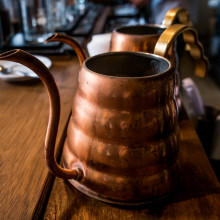
13:22 - A new use for ancient remedies!
A new use for ancient remedies!
with Luke McNally, University of Edinburgh
We’ve also asked each of our guests to bring something with them to the Edinburgh Science Festival. Microbiologist Luke McNally shows Chris Smith his very potent ancient potion... Be glad you can't smell this podcast!
Luke - This is a medieval antibiotic.
Chris - It's a milky fluid. I presume the jam jar's not medieval?
Luke - No, no. That's modern. I think possibly a Sainsbury's “Taste the difference” raspberry conserve, I think!
Chris - Are you going to take the lid off?
Luke - I will if you if you want a whiff of this. I'll tell the story first of what's in it. We all know antimicrobial resistance; bacteria evolving resistance to the drugs we use to kill them, is a big problem. We're looking all the time for new ways to discover new antibiotics. We need new weapons as bacteria find ways to overcome them. And a group of British scientists, led by Freya Harrison, decided to look in the history books. This is from an Anglo-Saxon medieval medical text called “Bald’s Leechbook”, and it's an eye salve, so it’s used to treat eye styes, which are infections of the follicle of your eyelash. The recipe for this is to mix equal parts either onion or leek, they're not sure from the translation of the medieval text which it was, garlic, wine and Ox gal which is the bile from an ox, and to leave it for nine days to brew in a brass vessel, and then afterwards strain it. And then you have this eye salve, which is meant to be applied with a feather to the eye to cure your stye.
Chris - Have you tried it?
Luke - I haven't tried it, no. Unfortunately this is only half strength, and this is what's really interesting about this: I couldn't get hold of any ox bile, so it's only about half strength. We always think that, you know there's all these ancient approaches to medicine, and often we think of them as very non-sophisticated. We know garlic is anti-microbial, but in this recipe they actually showed that it's the combination of the ingredients. Any of the ingredients on their own doesn't give you the full effect. It's really this unique combination that does it.
Chris - If you put that on a petri dish with some Staph aureus that causes sort of eye and stye infections and things, will it kill it?
Luke - Yes it will. It kills MRSA really, really well, which most people have probably heard of - a hospital superbug. They did mouse infections and it's able to kill the MRSA in those as well. At the moment there’s a lot of people trying to figure out exactly how it works, because it could help guide our discovery of new antibiotics.
Chris - Just a general question: if you actually put that on your eye, would I have an eye left afterwards? Cure my MRSA infection but it would also render me blind, possibly, or would it be okay?
Luke - Possibly, the smell might give you the answer, go on.
Chris - Oh my goodness. Actually, hang on, it's growing on me. That’s okay, actually.
Luke - It's not too bad. Garlic is the is the dominant smell.
Chris S - Give this a whiff, Beth, do you like this?
Beth - I will concur. Garlic is the very dominant smell.
Chris - A lot of garlic in there. Have you got any of that in your museum then, Sophie.
Sophie - Possibly in the brasserie.
Chris - You could have after the show. We might donate it. I mean how much of a problem is superbug infections now? Because we are increasingly being told, our own chief medical officer said, that the threat from bacterial infections we can't treat is rivalling terrorism in terms of the threat to humanity. Is that hyperbole or actually is that true?
Luke - I don't think that is hyperbole. There's arguments over the estimates. One prominent report said by 2050 this will be causing on the orders of millions of deaths, and costing millions and millions of pounds. And we probably are looking at something on that scale, if we don't act to stop the problem now. But there’s some happy stories as well where things have continued to work. Penicillin has been used to treat syphilis since the 1940s. And that still works to this day. There's never been any resistance to it. And so there’s causes for hope as well.
Chris - Just as just as well it still works, isn't it? Well, I can't speak personally in this case. I've got a question here from Steph who says: what do you think we're gonna be eating in the future, and how well prepared are we in terms of our microbiomes for this. Because one of the other things that’s your interest is the microbiome: literally we are what we eat, isn't it? What we put into our mouths affects the spectrum of bacteria that live on us and in us. How will foods of the future be considered in the light of what goes on in our intestines?
Luke - Oh, that's a very interesting question. I think in terms of our microbiome being able to deal with it there is a slight worry here. There's a new initiative, The Microbiome Conservancy, which is going to sample microbiomes from hunter gatherer tribes, and things like this, to make sure we have samples of all these microbes that could potentially be lost because of our diets changing. But generally it is a very flexible organ, in essence, in our body, and will pretty much adapt to most diets. That doesn't necessarily mean it'll be healthy. A lot of the time if you eat certain diets it can increase the amount of bacteria that can be harmful in the microbiome. But I would expect it to be flexible enough to deal with most of what we'd throw at it.
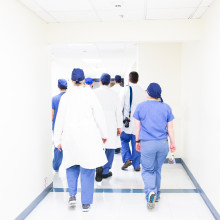
18:24 - Best Medicine: Thank goodness for anaesthetic
Best Medicine: Thank goodness for anaesthetic
with Sophie Goggins, National Museums Scotland
Sophie Goggins, curator of Biomedical science at National Museums Scotland, takes Adam Murphy through the horrible history of anaesthetics.
Sophie - Yes. From my point of view I definitely think the best in medical history in Scotland is the introduction of anaesthesia into surgery. If we cast our minds back to before having anesthetic during surgery your options were pretty limited. You could either be very drunk before surgery, you could have a whack on the head and hope you go unconscious, or that you pass out from shock, or just nothing at all. There's a very famous case in 1811 of Fanny Burney, who had a double mastectomy without any drugs whatsoever, and according to the surgeon “did not so much as murmur”, which I find unlikely.
Adam - What do we use first? What was the first kind of anaesthetic?
Sophie - Actually one of the first ones that was used usefully was opium. But then the discovery of nitrous oxide, or "laughing gas". When the person who discovered laughing gas went to go showcase it in the medical arena, they actually mucked up the way that it was administered and their patient cried out in pain. So, despite being the one that we still used today, it was the one that was rejected at the time.
They then moved pretty quickly onto ether, which is decent in terms of anesthetic but is pretty smelly and also very, very flammable. Two things that are a little bit of a problem during surgery. Also it caused your patient to excessively vomit, which didn't necessarily help with the kind of rate of recovery for patients. But then, of course, at the time what was more important for surgery was speed. You needed to be fast to be able to get your surgeries done in time. The one who's most famous is Dr. Robert Liston who could get off a leg in two and a half minutes, although after the introduction of chloroform he had it down to 25 seconds.
Adam - Did I read somewhere once he once did an operation with a 300 percent mortality rate?
Sophie - He did indeed.
Chris - Does that mean you kill someone three times?
Sophie - No, he nicked a patient's artery and then while trying to fix it went through the hand of the assistant who was helping him with the surgery, and then whilst spinning round actually nicked a spectator in the crowd.
Chris - What was he armed with, a chainsaw?
Sophie - I will also say he is quite famous for: while taking off someone's leg at speed, while trying to time himself to do the fastest amputation, he did also accidentally take off someone's testicle.
Chris - He sounds like the kind of surgeon you want, isn't it!
Adam - Brilliant, thank you very much. I am really glad we have anaesthetic now.
Sophie - Yes. We are very lucky that in 1847 James Young Simpson hosted a very famous dinner party in that instead of after dinner drinks you had after dinner drugs. He had his people who came to his dinners test out different types of potential anaesthetic liquids, or properties. He tested out chloroform on his patients after dinner, and everyone of course lost consciousness, and he used it thankfully again, tested it, and used it on patients later that week. It went on to be used by people like Queen Victoria who made it very popular.
Adam - And then I think everyone in the audience can choose: what would you rather? To get drunk, a bonk on the head, or just a good cry? Thank you, Sophie.
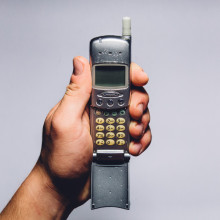
21:42 - Bizarre Technology: Shopping for phone signal
Bizarre Technology: Shopping for phone signal
with Chris Johnson, University of Glasgow
Chris Smith asks computer scientist Chris Johnson, from the University of Glasgow, to reminisce about the bizarre early years of mobile phones.
Chris J - As a kind of first step to a mobile phone. Well I mean probably the most important thing about modern mobile phones is that they’re cellular. So every 20 miles typically today you have at least one base station and your mobile phone is transmitting from your pocket or whatever to that base station. But obviously it took a long time for those base stations and that network to be fully built.
So then companies like this company Rabbit in the UK had the idea that they would they would enable you to make telephone calls but only in a very small number of locations where they'd done a deal with the shop owners to put in a very small base station. So it'd be like you know having the base station for your phone in your house but then having another one in local shops and these weren't like the current phone masts that we have, because the current ones do 20 miles approximately radius. These ones were 100 meters right. So I work in the University of Glasgow and our local base station for this phone network was in the Iceland frozen food shop. So today when you're on the train or whatever people home say “on the train, I'm on the train” the only conversation that you could have had with the first generation mobile phone would be “frozen peas. I'm moving on to the chicken section.”
Chris S - Chris did that lead to a lot of cold calling then?
Chris J - To me then the important point is this is like so much of technology that it becomes so ingrained within your life that even having a conversation about technology like that is a weird place that people sort of think” you're making this up aren’t you” but believe me there were hundreds of people, thousands of people in the UK carrying around the phone about the size of a small vehicle to the local Iceland shop so they could make a phone call.
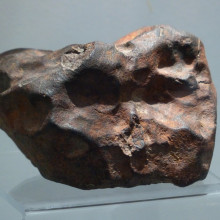
23:30 - Meet the Meteorites
Meet the Meteorites
with Beth Biller, University of Edinburgh
Beth Biller from Edinburgh's Institute of Astronomy brought something for Adam Murphy and the audience that was out of this world, quite literally!
Beth - I have a few meteorites, I think we can actually pass these through the audience but I'll start with this one. This is a chunk of iron from space. It is surprisingly heavy, actually it’s maybe not unsurprisingly heavy. It's part of a larger meteorite that fell in Argentina. There's chunks of this still in Argentina like tons of it left and this is the bit that the Royal Observatory owns and it's just a kind of impressive thing to hold.
And I hope you'll enjoy this without throwing it. But you might look at this and say well how do you know it's extra terrestrial, right? So this was found in the desert and it probably contrasted quite a lot with the environment it was in. It's dark, the desert is probably more tanny grey-ish but that's a good question. So I'll move on to this other little bit of meteorite I guess I can start passing this around. This is a slice through another iron meteorite, iron nickel meteorite. And what's cool about it is it shows something called Widmanstatten patterns. So when you look at this you'll see essentially little crystalline patterns, these little streaky patterns and this is a sign of its origin as an extra terrestrial object because the only way you can form this kind of crystalline pattern is if you let this cool extremely slowly, it took millions of years for the asteroid that eventually broke up and formed this meteorite to start a very hot state and to cool down and that's why you can get these very complicated crystal patterns. They can only cool about one degree every million years for you to get this kind of pattern, they're also very very pretty. So fun to look at, this one does need to stay in its case though
Adam - How many of these things crash into the planet every year?
Beth - Lots.
But in most places you can't find them right? If one of these fell in Scotland and fell on the grass you would never find it right. It would blend in and it just looks like another rock. I don't have an exact number but the way people generally search for these, they’ll go to local places like Antarctica. Right. So you have a nice wide expanse of snow. And if you have dark meteorite material it stands out quite well.
Adam - That’s awesome. Thank you.
Chris - And I see that there is now going around the audience, a fist sized lump of iron. Most people are discovering how heavy it really is.
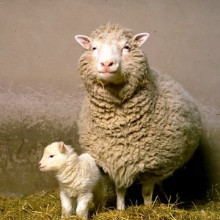
27:11 - Sir Ian Wilmut: Legacy of Dolly the Sheep
Sir Ian Wilmut: Legacy of Dolly the Sheep
with Sir Ian Wilmut, Roslin Institute & Scottish Centre for Regenerative Medicine
Sometimes a bizarre idea quickly becomes the best idea and one experiment in particular rocked the world of genetics. On 22nd February 1997, in a world first, researchers at the Roslin Institute in Edinburgh announced that they had taken the DNA from a skin cell of an adult sheep and inserted it into a sheep's egg cell from which the DNA had first been removed. The egg was placed into the uterus of a surrogate sheep where it developed and the result was a lamb they called "Dolly". She was so-named because the adult cell used to clone her came from an udder, so naming her after singer Dolly Parton seemed apt. Chris Smith was pleased to be joined by the scientist who led that work, Sir Ian Wilmut…
Ian - It’s a point which is very very important to make. You need a crew of something like 12 or 15 people to do this sort of experiment. So to say I did it would be seriously misleading.
Chris - Why did you start with sheep though?
Ian - The Roslin Institute has always been concerned with farm animals. And if you are thinking of using cloning in a farm animal species, either to improve their performance or to increase numbers, the species with the greatest commercial interest would be the cow. But cattle are extremely expensive to buy, to maintain and they have a very long gestation, so that if you're doing an experiment where you transfer embryos as you said into a foster mother, you've got to wait 10 months or whatever it is before you know the answer to the experiment. By comparison the sheep are much easier to look after. They’re are a lot smaller for one thing, they're cheaper, and their gestation is less than half that of cattle. So it was really thinking that sheep are small, cheap cows was the reason why we chose them.
Chris - How did Dolly go down? Were you sort of celebrated and did you get a good reception to what you announced you've done or did you face quite a bit of controversy?
Ian - We've got an enormous amount of publicity of course and a lot of skepticism. Some people doubted whether Dolly was really a clone. If you explain to people the reason why you're doing this sort of thing the majority would become supportive but a small proportion would be hostile to experiments with animals.
Chris - And some people expressed concern that perhaps there would be accelerated aging and that kind of thing on the part of Dolly. Was that borne out by experimentation?
Ian - It's actually very difficult to do the experiments in sheep. It's much easier to do them in mice. You really do have a shorter generation interval and lifespan. I don't think that there is any evidence of this but it's quite a difficult and expensive experiment to do.
If you have to produce another generation and wait another generation and wait, to see if your changing lifespan or not.
Chris - Because there's a recent paper in one of the Nature journals, where they actually got the skeleton of Dolly and C.T. scanned, because one of the criticisms had been that there was premature arthritis and did they not find from these studies that actually there was no evidence really that there was an accelerated rate of arthritis. She didn't really show any signs of that compared with say a sheep born the normal way?
Ian - I think that's right. Accelerated aging was just a very slick journalistic expression to indicate that things were not quite right but I don't think there's ever been really good clear data about the aging of cloned animals.
Chris - What would you like to see the long term outcome be? If you could now wave a magic wand and we'd be in a certain position or know a certain thing, what is the final big question that you would like to see answered now?
Ian - The general understanding before Dolly was that once a cell had formed a particular type it couldn't change or be changed artificially by us. What Dolly showed was that it is possible to change cells and we had mammary cells which became equivalent to embryo cells and we got viable normal offspring. And this has created important new opportunities in medicine. What it means is that if we have somebody who let's say has motor neurone disease which reflects damage to nerves that run down the spine. If we take skin cells from them we can treat them so that they become equivalent to embryo stem cells, the cells which have the ability to form any different tissue, and then change them into the cells which are damaged in the disease and for the first time we have cells which are equivalent to those in early stages of motor neurone disease.
So if you have got a disease of the central nervous system you can't have samples from a patient like that until they've passed away. And by then there may be many secondary effects of the disease. Now in this new situation you can use them to test drugs which may be effective in slowing down or even preventing motor neurone disease. I personally have Parkinson's disease so there is a chance of the same thing happening for that disease and I think that unexpectedly the Dolly experiment has revolutionized the approach to these inherited diseases. I really do genuinely believe that treatments will come along but it may very well be 50 years before the treatment becomes routinely available. So people like me will probably have died of Parkinson's disease before the new treatments become available which is a frustrating thing to think.

32:46 - Best Microbiology: Truth on Transpoosions
Best Microbiology: Truth on Transpoosions
with Luke McNally, University of Edinburgh
Getting back to the battle of the "Bests" Luke McNally, from Edinburgh University, makes the case of "transpoosions"; using good guts bugs to defend against bad bugs.
Luke - I think one of the big changes we've had as a result of the crisis we've faced with antibiotic resistance is starting to think differently about how we treat bacterial infections, as it is two ways that that happens. So one is with transpoosions where we give good bugs to fight the bad bugs. Right. And and trying to harness the good bugs in our microbiome as a way to stop infections but also many other disorders, metabolic disorders, can be affected by the microbiome. And so this approach of using good bugs is one of our major advances.
Adam - Who... And how... did we figure out it was a good idea in the first place?
Luke - It sounds as if a 3 year old could have come up put it you know, if you have a problem with your gut let's take poo from a healthy person and give it to you, maybe it'll make you better. And the reality is that a lot of our treatments at the moment, they are kind of crude to some extent because it is as simple as that.
It was really only when we started to discover the complexity of the communities of microbes that live in our guts that we started to think that this was even an option. But at the moment most of the treatments just take poo from a healthy person and grow the bacteria up from them and then use basically a nasoduodenal tube, so a tube up through the nose and down into the small intestine to infuse the full community of bacteria in. But now there's a lot more refinement. So we're starting to figure out which individual microbes are actually having these effects. Clostridium difficile infection, C. diff, a lot of you will have heard of. It’s a very important hospital acquired infection, kills a lot of people who go in for treatment with cancer because their microbiome gets depleted by antibiotics and then they get infected. We now know the bug in good poo that helps protect against that. It's another closely related species Clostridium scindens, that modifies our bile acids into secondary bile acids and those kill C. diff. It kind of works like a beaver dam, Clostridium scindens lives very high up in our digestive system and converts our bile acids and then lower down that suppresses C. diff.
Adam - And very briefly is there anything else we can do to protect our gut bugs other than transpoosions.
Luke - Yes we can. We can try to eat a healthy varied diet. One of the best things we can do to maintain our microbiome is varying our diet. You know if we eat the same things all the time the same bugs are going to grow more and more and it'll be less diverse than otherwise. Yeah. And that's one of the biggest things we can do. There's more and more probiotics that are useful but you need to do your research on them. A lot of them are kind of pseudo-scientific and there's not much evidence behind. But there are some good probiotics out there as well.
Adam - And I think it's probably the ultimate case of don't try this at home.
Luke - Yes. Yes. Do not try. Do not try faecal transplantation yourself at home.
There's been people who've ended up with infections as a result. There are people who tried to do this. I do not recommend it. There's banks of healthy faeces available to be used for this problem.
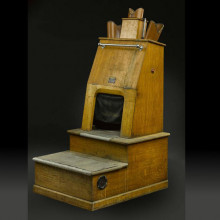
36:04 - Bizarre Medicine: X-Ray shoe scanner
Bizarre Medicine: X-Ray shoe scanner
with Sophie Goggins, National Museums Scotland
How dangerous can a trip to your local shoe shop be? Sophie Goggins, Curator of Biomedical Science at National Museums Scotland, takes Chris Smith through the machine that used X-rays scans to measure your shoes.
Sophie - I'd like to volunteer the pedoscope. Has anyone heard of a pedoscope before?
Chris - One or two people nodding knowingly.
Sophie - One or two people nodding. A pedoscope is also known as an X-ray fluoroscope. So they were found in shoe shops across the U.S.. the U.K.. South Africa. If you're of a certain age they were in shops from around the late 1920s to 1970s and they offered people in shoe shops trying on your shoes a live X-ray view of your toes inside your shoes to see if they fit properly.
Chris - Could you see the bones and stuff in your foot?
Sophie - Yes. What would happen is it's about four feet tall. It's clad in wood and you would step up onto a little ledge and put your feet in and you would then look down a gaze hole at the top and the operator would look down another one on the side and your mum or dad or whoever’s with you would look down one on the other side and you all look down and they'd press the big button and you get a live X-ray of your toes in your shoes. Apparently you could also see the stitching around your shoes and you're meant to wiggle your toes to see if there is enough room.
Chris - Is this not sort of, the cynic in me saying, this is some kind of dodgy sales ploy because they'll sell more shoes because you'll come back three weeks later for an extra pair of shoes for the two new legs you've grown because of the x ray exposure.
Sophie - Yes I think my favorite one is, I'm actually gonna get the year, so it was 1957 before the UK actually said that you shouldn't do this more than 12 times a year.
Chris - That's a lot of pairs of shoes isn't it.
Sophie - Yes. Obviously some people who are very into their shoes, but I think the greater concern was of the people that were operating these machines in shoe shops day in and day out.
Chris - Because they were getting a reasonable dose of X-rays then weren’t they. When did we finally get these things removed from shops?
Sophie - So they were never actually banned in the UK. They were banned in the US in 1953. But as I said it wasn't till 1957 that the UK actually put out a warning about them. And then they were found in shoe shops up through the 1970s.
Chris - I think I even remember, because I am of a sufficient vintage to have had probably my early pairs of shoes, I think I remember this. So you've got one in your museum - does it work? Have you had to go with it?
Sophie - I think this is another good example of don't try this at home.
Chris - We did ask you to bring it in but you said it's rather large because it's a huge great thing isn't it. You said it's four feet but you weren't referring to feet on your leg. It's a tall thing.
Sophie - No it's quite a tall machine. It was made in St Albans down in England and they're quite pretty, actually, to look at. So it's on the top floor of our museum if you want to go have a nosy. But it’s clad in wood, it looks very very nice. I mean obviously made a shoe shop experience quite an important exciting one for even more so for small children.
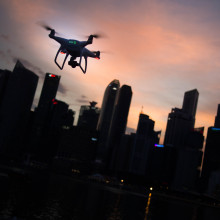
38:45 - Cybersecurity: Drones in Disguise
Cybersecurity: Drones in Disguise
with Chris Johnson, University of Glasgow
Is it a bird? Is it a plane? Is it a drone in disguise? Computer scientist Chris Johnson from Glasgow University shows Adam Murphy how a drone can mask as a Boeing-737.
Adam - In the news now we've seen a lot of things about drones like Gatwick drone being the infamous case that's come to mind. Now you’ve brought one with you, Chris. What's so special about your a little drone?
Chris J - Right now, the area that I work in, there's a huge question of this kind of technological battle, you know, defenders trying to protect against attackers not knowing all the things that they're going to do and not really having a playbook. Well I brought you here is a G.P.S. something called a DSP transmitter. Aircraft like ML360, you know the Malaysian aircraft that disappeared, you can detect them using two different technologies.
Primary radar, which is the kind of thing that you'll be familiar with from the Second World War. So you you ping out a beam of energy and you receive a signal back. OK. You only get an idea of the location of the object, you don't necessarily know its identity. So that's called primary radar. Secondary radar, what you do is you query the object and the object itself can provide back to you information about itself, so it sounds like a radio signal and that's called a transponder, typically, on an aircraft.
The benefit of that is if we use primary radar we have to have radar everywhere. Whereas what we can do with boxes like this is receive a G.P.S. signal and then broadcast our position to somewhere on the ground and we don't need all these all these base stations, these radar stations.
The good use of this technology is so we can attach this to a drone and what it will do is tell you where it is. That's good. Okay. The other thing that we could do of course is, if the drone can detect its location through its G.P.S. signal then if it goes near an airport, the manufacturer of the drone can prevent the drone from going inside the airport circumference. So that's good as well, right. What this box does is, because everybody else is much more optimistic and dealing with good bright areas of science and I deal with the dark underbelly of engineering. This is a G.P.S. jammer. So what it would enable me to do is to take out the G.P.S. system of an area of the UK or also emit signals that make it look like an aircraft.
Chris S - So your little drone could become a Boeing 737?
Chris J - Absolutely right.
Adam - And this is a tiny little white box that fits in your hand.
Chris J - Yeah it's it's no bigger than a fairly chunky phone. This one's never been powered up, before we get arrested. OK. Getting permission to test this in the U.K. is a really interesting example when they say “what are you going to do with it.” What we're trying to do with it is to work out, stay one step ahead of the attackers and at the same time be aware of what's possible.
Adam - Other than pranks, what could that be used for, what dangers could that bring?
Chris J - Right now, with the drone we could use geofencing, for example, to protect our airports and other critical areas. But if this was used in a destructive way it could have a massive impact by undermining confidence in air traffic control systems. There are other techniques that in the UK we can employ to get around that. And I'd rather not mention that on the radio.
Adam - Probably a good idea.
Chris J - I think there is a key point here which is that people, in order to be able to protect ourselves, just like I mentioned the National Cyber Security Center, you need to understand how the offensive technology has changed and if you aren't interested in where the next potential attack can come from, then you shouldn't be surprised if you can't defend yourself against it.
Adam - Wise words. Thank you very much Chris.
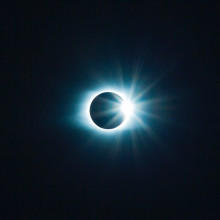
42:03 - Best Astronomy: Detecting Exoplanets
Best Astronomy: Detecting Exoplanets
with Beth Biller, University of Edinburgh
Could you spot a firefly next to a lighthouse? That's a similar issue astronomers face when trying to see planets outside our solar system (exoplanets). Astronomer Beth Biller from the University of Edinbrugh explains to Chris Smith how they get around that issue as the best thing in Astronomy.
Beth - I'm going to go with detecting and characterizing exoplanets. So again, exoplanets are planets orbiting stars other than our sun. And I want to talk a little bit about how we know what they're like. So as we saw earlier for planets in our own solar system, our initial attempts at characterizing them went kinda disastrously wrong. There are no canals on Mars as we know.
Most of the planets we've detected around other stars today, we've done so indirectly because of their slight tug on their star or because they pass in front of the star and dim it just a little bit. If we want to understand what planets are actually like, we need light from the planets themselves. If we have light from the planet itself we can get a sense for how warm it is, how cold it is. We can get a sense of what it's made out of, at least what its atmosphere is made out of.
So one technique to do this, the one that I work on in particular and hence the one that's nearest and dearest to my heart, is direct imaging of exoplanets which is when we just try to take a picture of an exoplanet next to a star. Obviously this is really challenging, right, cause stars are really bright and planets are not so bright so it's kind of like trying to take a picture of a firefly next to a lighthouse. If the lighthouse and the firefly were in Dublin and we're here in Edinburgh.
Chris - That's quite some way. So is there a way of potentially masking the sun or the star so that that light can't bleach out the fireflies. You can still turn really sensitive equipment on your firefly and therefore see it.
Beth - Exactly. That's what you need to do to get the contrast necessary to actually image your firefly next to your lighthouse. So first of all you have to do something about the atmosphere. One solution to this is to put your telescope in space. Once you've done that, well, the next obvious step is let's block out the light from the star, right. The instrument to do this is something called a chronograph.
Chris - How does it work?
Beth - The same way as if you see the sun is very in the sky you block, put your hand in front of it and block it out.
Chris - So you can put something in the field of view of the telescope which just covers the star but doesn't cover the tiny speck of light that you hope is there. There's the planet you want to see.
Beth - Exactly. So we've used this already to detect a number of planets. These are planets very unlike our own. They're what I like to refer to as baby Jupiter so they're like Jupiter but much younger. There are maybe 10 to 100 million years old. And yes I realize that's only young in the world of astronomy, but because they're young, they're a lot warmer than they are at later ages and hence brighter. So that's what we've done so far. The hope is eventually to push these technologies down to lower mass planets and cooler planets, eventually imaging planets like our own.
Chris - Can we also not, by looking at the light coming through the would-be atmosphere of the planet, learn something about what's in that atmosphere, because you can assume that if the lights go to go through the atmosphere and there are chemicals in there that might soak up some of the light, and different chemicals soak up different colors of light, if you look at different colors you could tell what's in the atmosphere and therefore you could spot and you can learn quite a bit about the weather and the climate and what sort of environment of that particular planet may be without actually ever having to go there.
Beth - Yeah exactly. So this is the power of spectroscopy, right. Looking for the fingerprints of different atoms and in particular when you're talking about cool planetary atmospheres, molecules in your atmosphere. So for instance there's already been detections of water and methane in exoplanet atmospheres, by looking at their spectra from the light of the star passing through the atmosphere. So that's one technique that's used. Also by actually getting your directly image spectra of the planet itself.
Chris - Thanks Beth.

45:47 - Bizarre Microbiology: Criminal Microbes
Bizarre Microbiology: Criminal Microbes
with Luke McNally, University of Edinburgh
Fingerprints can help catch a culprit, but what about their microbes? Luke McNally, from the University of Edinburgh, takes Chris Smith through developing techniques that could use microbes to catch a criminal.
Luke - We’ve talked a lot about the good things our microbes can do for us. Good bugs in our microbiome but one negative is if you commit a crime it's likely they're going to get you caught soon. And so what we're finding is that actually microbial forensics is one of the most exciting areas for use of microbes. There's a few different ways that they might get you caught. The first thing, and probably the most advanced area in microbial forensics, is in trying to time when someone died in, for example, a murder case.
Historically we'd look directly at a body and say “oh, well you know the signs of rigor mortis. So the person has at least been dead for this long”. Or if a body has been outside for a really long period of time, via what insects are consuming it you can tell how long it's been dead. Well there's a similar thing that happens with your microbes. So once you die your microbes start eating you. There’s no immune system to block them anymore. Lots of the microbes that are in our gut, they'll happily sit there once our immune system is keeping them under control, but as soon as that's not the case they'll begin to eat you and consume nutrients. And so what we see is this kind of a clock of microbes that runs as a body is decomposing, both from the bugs within you and from bugs that come from outside. And so that can give us a really tight timeframe on how long it is since a murder occurred, for example.
But the other thing that microbes can tell us is who's been in contact with whom or, for example, where someone has been. If two individuals shake hands, if you sequence the bacteria from the hand of one of those people you can tell who would they shook hands with them. Communities that are on us are like our fingerprints. So just like DNA fingerprinting has been used in terms of measuring our DNA and using that to tell who's committing crime and we can use DNA fingerprinting of our microbes in just the same way.
Adam - And we can open up a whole new Crime Scene Investigation TV show…
Luke - Exactly!
Adam - ...CS Microbe!
Luke - Exactly! This has been entering some of the CSI shows at the moment but the science isn't nailed down hard enough yet for it to really be rolled out at that scale. But it's something that's on the horizon quite soon.
Adam - And I think the final takeaway is don't do crime!

48:09 - Phrenology: It's all on your head
Phrenology: It's all on your head
with Sophie Goggins, National Museums Scotland
Do the lumps and bumps on your head mean anything? Sophie Goggins brough a special guest with her and helped Chris Smith bust the myths of Phrenology.
Sophie - This is a lovely phrenology head. It's a cream ceramic skull that seems to be split into different types of areas. And this was a pseudo science that was pioneered, if you can use that word, by Franz Joseph Gall who believed that the brain was split into different faculties and that it was like a muscle. You had bigger bits of your personality like, for instance, I'm looking at here “the hope for your future” or your “sublimity” or your “consciousness” or, I quite like that there's the ones in the back, but “amorousness”, could be seen from the lumps and bumps of your head. He believed that your brain actually formed the different peaks and troughs of your skull and you could tell bits about your personality. It is of course a pseudo science but one that was believed pretty widely from 1810 to 1840 and Edinburgh was the european home of phrenology.
Chris - So basically, looking at this head you've got here, there's a map drawn on the surface with words corresponding. If I fondled your head and I felt a bump in that particular area, you say “oh, that's your dignity centre”, you must be very enriched for dignity. I see at the back here, this is obviously the love centre because we've got “conjugal values”, you've got “marriage” there at the back. Because that bit at the back there is actually where your External occipital protuberance is, the bulge on the back of the head… And didn't they say that if you've got a big one of those, you've got a big something else, wasn’t that the claim?
Adam - Well there’s a lot of people in the audience fondling their own head.
Sophie - So that was indeed the claim. And for instance there was actually a group of phrenologists in Dumfries who dug up Robert Burns’ bones to get a cast of his skull to see whether or not his poetic centre was particularly large. But they actually found that his love of children and his ability to make children was especially large portion of his skull which if you know his story of course is true.
Chris - There was something about pickpockets. Wasn’t it round the side here, above the ear. There's something here…
Sophie - Yes, we've got a bit of an audience participation. If you have a little feel above your ears, you might feel a little bump. You can feel whoever you're with if you ask them nicely. Apparently this actually came about because Franz Joseph Gall went and surveyed all of the pickpockets, just pickpockets, to see what area of their skull made them more prone to pickpocketing. Apparently there's that little bump just above your ear and the bigger it is the more likely you are to steal.
Chris - When did this fall out of favour, when did people discover that this is just bunkum? The shape of your brain, whilst it is divided into different bits, the brain doing different jobs has no bearing really on the shape of your skull?
Sophie - Around the eighteen forties because, quite embarrassingly, the Phrenological museum is actually here in Edinburgh, it was right across the street from Chamber Street and you can see above all the windows there's casts of the skulls of the great men of phrenology. Now the problem was that when these men passed away and casts were taken of their own skulls, the kind of traits that they were actually showing weren't what they maybe would have wished them to be. A lot of them actually showed up to be they'd be murderers or pickpockets but were the great men of phrenology.
Chris - It suddenly fell from favour and was withdrawn quietly and disappeared, is that what you’re saying?
Sophie - I think it was actually quite a lot of drama and debate in Edinburgh society about phrenology and a lot of great very Victorian arguments through correspondence. But it did indeed fall out of favour, thankfully!

51:36 - Over to you.... Any questions?
Over to you.... Any questions?
with Chris Johnson, University of Glasgow, Beth Biller & Luke McNally, University of Edinburgh
Time for some quick fire questions.... Chris Smith asks our panel to whizz through the questions sent in from the audience!
Chris - Brody, brilliant question this one! This is for you, Luke..
“When and if the ice in the Arctic melts, is there a chance of there being pathogenic - in other words, harmful - microbes and deadly diseases locked up in the ice? “
Luke - That's an excellent question. I'm just part of a bid that, hopefully the EU will fund, to see if that's the case. So we're looking at the melt from the Arctic. There is a risk, we know when we've looked in Arctic cores before we've seen antimicrobial resistance deep down in those cores because it's ancient bacteria evolved to resist the antibiotics of others. But, yeah, there is a chance that that might be the case so we need to worry about it.
Chris S - Thank you very much for that. Alison Bramley says,
“How will we find life on other planets and how will we know, Beth?”
Beth - All right. The “how will we know” part is really tricky. First step, find and characterise a planet like our Earth. We have a few that are sort of like [Earth] but we don't know because we've not seen their atmospheres. That is going to take space missions in the 2030s and beyond to image these objects and to get spectra. Once we have spectra of the objects, we can look for the fingerprint of different molecules, different things going on, and then we start looking for biomarkers. Now this is tricky because you might think “oh, oxygen!”.
Chris S - ...20 seconds to go!
Beth - Let's look for oxygen. There's other abiotic ways to do that. You have to look for the right combination to really show that you may have life and it would be best if you had a lot of planets to do this work because if you find this just one planet who knows you really need an ensemble to say.
Chris S - Thank you, Beth. Jamie says,
“What problems can we anticipate for cyber security of self-driving cars Chris?”
Chris J - Whoa! Whoa! Whoa!
Adam - One minute!
Chris J - Okay, the Department for Transport which is part of the UK government has issued some principles on how to secure connected and autonomous vehicles. People that are developing the vehicles are very aware of the possibilities. Equally, people are experimenting with more and more interesting offensive techniques and those two things, as I said in the previous answers, go together. The protection goes alongside an understanding of the threat.
The kinds of things people can do are to attack the inner computer networks that control the vehicle or they can attack the sensors. I've seen some military projects that are looking at systemic vulnerabilities in the artificial intelligence that's used by the vehicles to identify that kind of scenario.
Chris S- … 10 seconds!
Chris J - Very, very quickly. Funniest example of an autonomous vehicle right now. I went across the states looked at a demonstrator, one case study they're working on is what happens when a member of the police walks out into the middle of the road to stop the autonomous vehicle? The autonomous vehicle says it's a pedestrian, manoeuvers around and escapes.
Related Content
- Previous What causes cyclones?
- Next Gaming Addiction










Comments
Add a comment